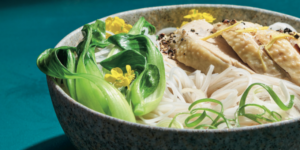Try Homemade Mead For a Very Viking Thanksgiving!

A thousand years ago, the people who lived the Viking lifestyle enjoyed a myriad of foods and beverages and threw feasts that lasted several days to show off what they had stockpiled throughout the harvest season. Bring the Viking spirit of celebration to your Thanksgiving table this year with a traditional batch of spiced orange mead.
Brew up the following recipe from Jereme Zimmerman’s new book Make Mead Like a Viking for a quick and easy mead that is ready to drink in just a few weeks and is full of festive spices ideal for warming up during the holiday season.
And, for an even more authentic Viking feast, ditch the turkey and try one of the suggested goat recipes using the links below.
Skal! (Cheers!)
The following is an excerpt from Make Mead Like a Viking by Jereme Zimmerman. It has been adapted for the web.
(Illustration: A scene on a stone from Gotland, Sweden, on display at the Swedish History Museum in Stockholm. The image represents participants in drinking rituals that were common in formal feasts called symbels and less formal feasts called gebeorscipes. Photo Credits: Berig, Wikimedia Commons.)
Skald’s Verse-Bringer Spiced Orange Small Mead
While mead is strongly associated with Vikings, it may not have been the type of mead we know of today. Honey was used as a fermentation medium whenever possible, but rarely was it simply honey, water, and yeast. Often grains were incorporated as well to make a type of honey ale (also known as bragot), and drinks in various stages of the fermentation process were blended to make a type of grog. Most mead was made and drank young, although it was also aged in barrels. While wild yeast was generally used to initiate the fermentation process, the Vikings would use actively fermenting batches to start a new batch, and save yeast strains they particularly liked by allowing them to cake up on totem sticks or magic sticks that they would use to stir up a new batch.
To make a quick mead that can be ready to drink within a few weeks of brewing and that is full of festive spices for the holiday season, try the following recipe for Spiced Orange Small Mead.
Makes 1 Gallon (4 liters)
Ingredients
2–3 pounds (1–1.5 kg) light, floral honey
1 gallon (4 L) water
1 organic orange
1 teaspoon (5 mL) or 1 packet bread yeast
2 tablespoons (30 mL) barm, or wild yeast
Spices (2 cinnamon sticks, 2–3 cloves, 1 crushed nutmeg seed, 3 crushed allspice seeds)
2–3 ounces (57 to 85 g) ginger, fresh grated or 3–4 thin slices (optional but recommended)
Process
1. Pour water into a pot and heat to around 70° F (21° C).
2. Mix the honey with the water until it is well dissolved and pour the must back into the water jug with a funnel to about 2 inches (5 cm) below the neck.
3. Slice the orange into eighths and remove the rind from all but two or three slices to avoid an overly pithy flavor.
4. Add yeast or barm and all the spices, put the lid on tightly, and shake the jug like you mean it.
5. Place an airlock and cork in the opening, or cover with a balloon, condom, or plastic wrap held on loosely with a rubber band.
I recommend racking (transferring to another jug, leaving any sediment behind) at least once, but this isn’t a mead designed for bottling (although it certainly wouldn’t hurt to bottle it and age for a couple of months). After about a month, start tasting it. When you like it, drink it.
Roasted Goat Recipes
For food, the vikings would have had lots of meat available that had been preserved through drying and curing. As they prepared for the cold months, they would slaughter any animals they didn’t want to keep through the winter, preserving as much meat as possible. Certainly some of it was cooked up “fresh” as well. They would also preserve and eat various wild birds and sea animals, including a dish that is still popular in Iceland today that is often referred to as “rotten shark.” Hákarl is a dish that Scandinavians who settled Iceland during the Viking era developed due to the minimal sources of food available. Essentially, they take a Greelandic shark, behead it, bury it in the sand, and place heavy rocks over it. This causes the liquids from the shark (which are poisonous to humans) to seep out, and the meat to ferment. It is then taken from the ground after 6-12 weeks, cut into strips and hung to dry. To outsiders, the meat smells and tastes rancid, certainly making it an acquired taste. Icelanders proudly continue to produce and eat this delicacy as an homage to the thriftiness of their Viking forbears.
 For those of us seeking a more palatable experience, thankfully there are other options more palatable to the general public. People of the Viking era raised a fair share of sheep and goat. The parts of these animals that hadn’t been dried or fermented would have been cooked up for feasts and celebrations, either whole on a spit, or by quartering the carcass and boiling or pit-roasting it. To emulate this without building a fire or manning a spit, you can slow roast sheep or goat cuts in the oven or a crockpot on low heat. The Vikings had access to many herbs and seasonings that are common today. Cumin, parsley, marjoram, thyme, and garlic have all been identified from Viking graves and ship burials. Since the Vikings traded extensively, they would have had access to many more exotic herbs and spices. Following are links to a couple recipes to help inspire your Viking Thanksgiving!
For those of us seeking a more palatable experience, thankfully there are other options more palatable to the general public. People of the Viking era raised a fair share of sheep and goat. The parts of these animals that hadn’t been dried or fermented would have been cooked up for feasts and celebrations, either whole on a spit, or by quartering the carcass and boiling or pit-roasting it. To emulate this without building a fire or manning a spit, you can slow roast sheep or goat cuts in the oven or a crockpot on low heat. The Vikings had access to many herbs and seasonings that are common today. Cumin, parsley, marjoram, thyme, and garlic have all been identified from Viking graves and ship burials. Since the Vikings traded extensively, they would have had access to many more exotic herbs and spices. Following are links to a couple recipes to help inspire your Viking Thanksgiving!
Recommended Reads
Thanksgiving Takes an Adventurous Twist with This Foraged and Fermented Menu
Recent Articles
Winter just got cozier! Our simple & nourishing soup is just what you need to cozy up on chilly days or nights! Delicious and nutritious, this soup is perfect for the whole family.
Read MoreIndulge in the sweet aroma of these pastry-wrapped pears! Easy to make and stunning to serve, these pastry-wrapped pears are a game-changer.
Read MoreDitch boring snacks and upgrade to adorable fruit & veggie treats you’ll love! Brighten up snack time this winter using fruits and veggies we all know and love. Can you resist taking a bite of these cuties?
Read More










